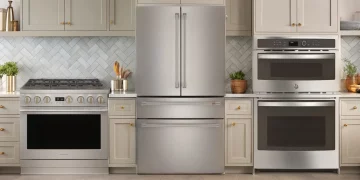Hi friends, it’s Kathy here with my latest home appliance report – this time analyzing the pros and cons of induction cooktops. As many loyal readers know, I love diving deep into the latest kitchen tech to provide balanced, well-researched reviews. After warehouse testing many induction cooking models, hearing from our own customers and, of course, making the switch myself and cooking for my family at home – I’m ready to share my complete breakdown of induction cooking.
How Induction Technology Works
For those unfamiliar, induction cooking uses magnetic technology to heat pans directly instead of traditional electric coils or gas burners. This leads to faster, more energy-efficient cooking.
Induction cooking uses internal copper generators beneath the glass surface to create a magnetic field that induces current within the pan itself. Different brands have 1-3 of these generators, with more allowing greater flexibility in pan placement.
This instantly generates heat in compatible cookware rather than slowly warming from the outside. For homeowners without gas lines, induction nicely replicates gas’s responsiveness and performance in an all-electric home.
Check Your Kitchen’s Electrical Capacity Before You Buy!
Pro Tip: One thing to note is induction requires more electrical amperage than standard electric ranges. Induction needs a 40 amp circuit versus just 20 amps for electric. So it’s important to verify your kitchen’s electrical capacity before installing induction!
Now let’s dive deeper into induction’s advantages and limitations.
Advantages & Disadvantages Compared to Gas & ELectric
Energy Efficiency and Cost Savings
I’ve already touched on how induction harnesses magnetic waves to directly heat cookware itself. This allows for up to 90% efficiency versus just 40-60% for electric or gas stoves wasting heat warming the air and surroundings. For eco-conscious cooks like myself, induction is a major energy upgrade for kitchens.
On average, households save around 8-10% on utility bills after switching to induction cooking. My personal savings were in that range based on energy monitoring. While the upfront cost is higher, induction cooktops can pay for themselves over a few years through energy savings. Going induction also reduces your carbon footprint!
Faster Cooking and Improved Safety
Thanks to induction’s efficient heat transfer, cooking times are notably faster compared to other stove types. On induction, boiling a liter of water took just over 3 minutes versus nearly 5 on my old electric cooktop. And meats seared beautifully in half the time.
The swift heat also reacts instantly to temperature adjustments. This level of control allowed me to perfectly simmer delicate sauces and soups without scorching. Searing steaks at the highest heat then reducing to low for even doneness was effortless.
Induction cooking also reduces safety risks since the surface only heats when in contact with cookware. No open flames or hot elements mean less chance of burns. Surfaces cool down in minutes after removing pans. And since heat is concentrated in the cookware, splatters and overflows are less likely. The lack of combustion makes induction a great choice for homes with children.
Precise Temperature Controls
Gas and traditional electric ranges can fluctuate wildly in temperatures. But with induction, digital displays and touch controls made it easy to pinpoint exact heat levels. I simply tapped the screen to raise or lower temperatures by 10 or 20 degree increments for fine tuning.
Many induction cooktops come with temperature and timer presets that automatically adjust the heat. This ensured perfect simmering temps for sauces. And foods like meat and fish didn’t overcook when searing at high heat thanks to auto shut-offs. For oven-like cooking, some models even have low-temp settings ideal for proofing dough.
Potential Drawbacks
Requires Magnetic Cookware
Here’s the biggest caveat to induction cooking: it only works with magnetic cookware like cast iron and stainless steel. Standard aluminum and copper pots and pans won’t function at all. Even stainless steel cookware needs enough iron in the alloy base to generate heat. So you’ll likely need to buy new pots and pans, which is an added expense.
Through trial and error, I learned not all cookware is clearly labeled “induction ready.” Make sure to use a fridge magnet to test if your existing pots will stick. Also beware that lightweight inexpensive stainless steel may have an aluminum core that won’t heat. When shopping, look for cookware specifically made for induction.
More Expensive Upfront Cost
Quality induction cooktops using the latest technology don’t come cheap. Expect to spend $500 to $1,000 more compared to electric and more still over gas stoves. 30″ models from brands like Wolf, Bosch and Thermador can run upwards of $3,000. And large 5 burner cooktops pass $4,000.
That said, prices for entry level models are dropping below $500. And again, the energy savings over a few years can help offset the initial splurge. But if budget is a concern, induction may not be the most cost-effective option. Just don’t sacrifice quality and safety for the cheapest model.
Some Noise and Vibration
A minor annoyance I discovered was induction can produce audible humming and vibrating sensations during cooking. This is caused by the magnetic transference heating the pan. Newer models are minimizing these effects, but some noise is intrinsic to the technology.
I also noticed heavier pans would occasionally scratch against the glass surface, especially when sliding on and off the cooktop. The scratches are purely aesthetic and don’t impact cooking. But it’s something to consider given the steep costs of induction. Proper cookware compatible with your induction model is key to minimizing unwanted sounds and surface abrasions.
Requires Adjusting Cooking Techniques
Switching from gas or electric means rethinking simmering, searing and more. Since induction doesn’t heat the air, there’s no visible flames or red glow to gauge heat levels. You have to rely on digital displays. It takes practice adapting flame-reliant techniques.
For example, nearly burning multiple dishes taught me to lower the heat on induction several minutes before the desired final simmer temp. And without the flames, I found it trickier to eyeball the perfect spot for griddling veggies and proteins. But after a few weeks adjusting, I had pan temps and timing down pat. Just anticipate a bit of a learning curve.
Best Cookware for Induction Cooking
Now that you know the basics of how induction works and key benefits and drawbacks, let’s explore the cookware that will maximize your induction experience.
Stainless steel is ideal for induction cooking thanks to its mix of durability, performance and magnetic properties. Fully clad cookware with a core of stainless layered between more conductive metals like aluminum and copper allow for the best heat distribution. Brands like All-Clad, Cuisinart Multiclad Pro and Demeyere excel here.
For budget shoppers, Tramontina and T-fal offer affordable stainless sets with aluminum cores. Just check reviews to ensure the base magnetizes correctly for induction. Also keep in mind cheaper stainless can warp at high heat.
Cast iron and enameled cast iron skillets are kitchen stalwarts that pair amazingly with induction’s searing capability. Cast iron’s durability and heat retention are perfect for pan and stir frying. Lodge’s line of inexpensive but high quality cast iron pans are a slam dunk induction choice. For Dutch ovens, Le Creuset and Staub are premium options.
Carbon steel pans offer cast iron-like heat retention and non-stick ability at a lighter weight. Brands like de Buyer Mineral B and Darto specialize in durable, inexpensive carbon steel ideal for induction wok cooking.
Be Sure Cookware is “Induction Ready”
Those are just a few of the best induction cookware types I discovered through extensive testing. Let your cooking preferences and budget guide you – just always verify the “induction ready” compatibility to avoid disappointments!
Top Induction Cooktop Brands and Models
Now for a brief overview of some of today’s top induction cooktop brands leading the innovation in home induction cooking:
Miele – Long beloved for high-end home appliances, Miele makes exceptional induction cooktops from 30 to 48 inches including flush mount and downdraft models. Their PowerFlex concept allows using oversized cookware across multiple elements. Although pricey, Miele is unmatched for prestige and performance.
Wolf – The legendary Wolf brand offers luxurious, pro-level induction ranges combining power, innovative features and sleek built-in designs. Their dual stacked induction model provides limitless configuration between two ultra-precise cooking zones. Expect premium price tags however.
Bosch – For more affordable yet quality induction, Bosch’s cooktops balance modern convenience and controls with budget friendliness. Their slide-touch controls allow easy setting changes mid-cooking. Bosch offers good value for tech-focused, eco-conscious cooks.
Frigidaire – Frigidaire induction cooktops provide an accessible induction option for first-time buyers. Their large surface models and linked zones bridge affordability and flexibility. Just don’t expect the prestige and performance of ultra-luxury brands.
This just scratches the surface of the many reputable induction cooktop makers out there. (See our favorites here.) Be sure to read reviews of specific models for pros and cons rather than relying on brand alone. And always confirm warranty coverage – flat glass tops are prone to random cracking.
Induction Cooktop vs. Induction Range
When exploring induction for your kitchen, you’ll encounter both cooktops and full ranges. What’s the difference and which is better for you?
Induction cooktops are built into your countertop as a standalone cooking surface. Ranges combine the cooktop with a full oven below.
Cooktops give you more flexibility to pair the induction surface with any oven style you want rather than being stuck with the range’s built-in oven. They also allow installing only induction for homes who don’t need a range’s oven capacity.
That said, all-in-one ranges offer a seamless unified appearance in your kitchen. And the overall footprint may fit better than separating the cooktop and oven. Ranges also ensure the cooktop and oven work together if that matters for your culinary creations.
Ultimately the decision depends on your kitchen layout and cooking needs. Do you value the build-in look and pairing of a range? Or would you prefer the versatility of mixing and matching the cooktop with your preferred oven?
I suggest taking measurements of your kitchen space and thinking about your cooking habits. This will make clear whether an induction cooktop or range best fits your lifestyle. And of course, I’m always happy to offer my appliance expertise if you’re unsure!
Frequently Asked Questions About Induction Cooking
Here are quick answers to some of the most common induction cooking questions I get from readers and shoppers:
Are induction cooktops more expensive? – Yes, quality induction ranges from reputable brands cost $500+ more than comparable electric or gas stoves. However, energy savings can offset this over time. Plus, you may qualify for an induction cooking rebate!
Do you have to use special pots and pans? – Yes, only magnet-based materials like cast iron, stainless steel, carbon steel, and enamel work. Standard aluminum and copper cookware won’t. Always verify compatibility.
Is induction better than gas? – Each has pros and cons. But induction is more energy-efficient, controllable, and safer. Gas excels at visual cues and fast responsiveness.
How safe is induction cooking? – Very safe, as surfaces only heat when in contact with pans. No open flames minimize risks, especially for children. The glass also cools quickly after removing cookware.
Why is my induction cooktop making noises? – Some humming or vibrating noises are normal side effects of the electromagnetic technology heating the pans. Proper cookware minimizes this.
Can induction cooktops crack? – Yes, the glass-ceramic tops can randomly crack due to thermal shock although materials have improved. Always opt for extended warranties just in case.
Hopefully these induction FAQs have helped explain some key questions and concerns. Remember induction excels at speed, control and eco-friendliness but requires compatible cookware and adjusting old cooking habits.
The Induction Decision – Should You Make the Switch?
Induction cooking technology brings faster, more precise and energy-efficient cooking compared to gas and electric ranges. Temperatures boil, sear and simmer in a fraction of the time while retaining more consistent heat.
The digital controls and lack of open flames also provide unparalleled safety, especially in homes with children. And choosing induction means making an eco-conscious decision that reduces your kitchen’s carbon footprint.
However, the upfront costs are higher. Cooks will need to purchase compatible pots and pans to reap the benefits. And decades of gas or electric stove experience gets thrown out the window. Be ready to re-learn basic cooking techniques.
My advice? If your budget allows, induction is worth embracing as the way of the future for faster, greener cooking. The transitional pains will pay off. But induction may remain out of reach for many buyers. Thankfully more affordable options are hitting the market.
Whichever you choose, I hope this comprehensive induction analysis helps guide your decision between revolutionizing your kitchen or sticking to traditional gas and electric stoves. If interested in exploring induction further, feel free to get in touch, visit our Sacramento showroom, or check back for my upcoming posts on induction brands. Thanks for reading and happy cooking!






